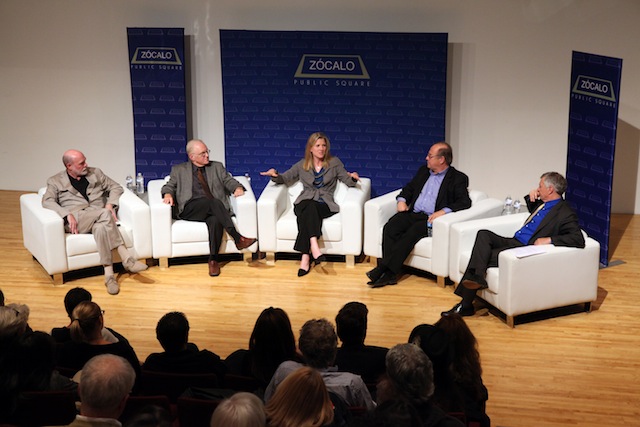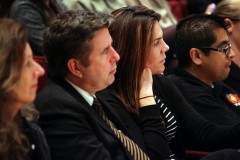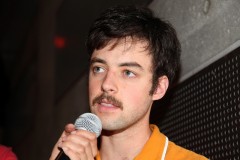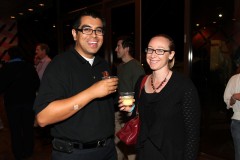
What was traditionally California’s most heated rivalry–that of north versus south–may soon give way to a different divide. At an event co-presented by the Huntington-USC Institute on California and the West, a panel with roots in both Los Angeles and the Bay Area questioned whether California’s north-south divide will be replaced by the chasm between California’s east and the west.
Conan Nolan, general assignment reporter for NBC4 Los Angeles, moderated the event before a large and enthusiastic crowd at the Grand Avenue MOCA. He opened the evening by asking panelists if L.A. and San Francisco could be considered more natural political and cultural allies than, say, L.A. and Riverside. “Do the north and south on the coast have more in common than the north and south in inland California?” asked Nolan.

LA Observed creator and publisher Kevin Roderick answered that the coast is one California, and inland is another. But he noted that the Northern-Southern California divide remains important–and that, for now, the balance politically seems to be tilted toward the north. Governor Jerry Brown, who grew up in Northern California but spent time in Southern California, “won because he got the votes in Southern California” and may be “the perfect candidate for this era.”
Turning to University of Washington historian and Silicon Valley history expert Margaret O’Mara, Nolan asked how much the shift in power towards the north might have to do with the rise of Silicon Valley. While O’Mara didn’t indicate a major role for Silicon Valley in the north-south power flux, she did note that Silicon Valley has a much more self-reliant mentality than many regions, such as Los Angeles, do. “We’re entrepreneurs [in Northern California], pulling ourselves up by our bootstraps,” she said.
Many entrepreneurs in Silicon Valley therefore feel removed from public policy and reluctant to support one political side over another. The irony, though, is that the secret to building Silicon Valley was federal support. In any case, O’Mara felt that, to the extent Silicon Valley could be called a power player, this could soon change, because of a history of “boom-bust, from the gold rush to the Cold War to the era of Apple and Google, and on and on and on.”

UC Berkeley historical geographer Gray Brechin expressed skepticism toward the idea that the north so easily trumps the south in power nowadays. “L.A. has such a gravitational pull to it,” he said. Alongside San Francisco, Los Angeles is “like Jupiter compared to the Earth.” But San Francisco has a political infrastructure that Los Angeles lacks. “The old Phil Burton political machine … keeps going on like the Energizer Bunny,” Brechin said, pointing to Dianne Feinstein and Jerry Brown. “It just doesn’t stop.”
Allan Mayer, the founding editor of L.A.’s Buzz magazine and a Hollywood crisis management specialist, took a less nuts-and-bolts view of California’s balance of power and focused more on cultural intangibles. “What you have [in L.A.] is an entertainment complex that defines popular culture, not just in this country but for most of the world,” he said. While Hollywood is dwarfed by the tech industry when it comes to revenue, “this much smaller community that we have here wields this enormous influence.”
Nolan asked the panelists if they felt that the state’s size was a drawback. Does California’s size diminish, rather than enhance, its national and global influence? And is size also to blame for the state’s inability to form consensus and achieve any sense of continuity? To both questions, the panelists were in agreement on the answers: no.
First, they said, California is still hugely influential.
“We are the center of most of the high-tech innovation that matters [and] the center of the biggest generator of popular culture,” said Mayer, who pointed to Arnold Schwarzenegger as an example of someone “worth studying if you want to know how celebrity culture and mass media intercept.”
“For the rest of the world there is no north-south” divide, added Roderick.
Second, they said, California’s size, while large, is not primarily to blame for the political dysfunction of the state. That has to do with many other factors unrelated to surface area.

Brechin, who has taught at UC Berkeley for 44 years, offered a grim assessment of how the health of the state has declined, pointing to a student body apathetic to politics and a university plagued by financial difficulties. “California does have this mythic image around the world, but it’s losing it,” he warned the crowd. “You asked who runs California? I’d say who ruined California. And my vote goes to Howard Jarvis” and Proposition 13.
In a lively question-and-answer session, Brechin said that during the Great Depression, thanks to the New Deal, “California pole-vaulted from the 19th to the 20th century” with massive public projects and huge gains in infrastructure. However, today, as the system breaks down, we’re increasingly going back in time.
Ultimately, the panelists agreed that change in California would most likely be brought about not by a tug of war between north and south but rather by a growing divide between east and west–i.e. coastal and inland. “I do think there’s going to be some issue that’s going to tie together the inland parts of California in some way in opposition to the coast,” said Roderick. “It’s a very interesting split in the state to watch.” He pointed to growing homogenization along the coastline–and a less heated Giants-Dodgers rivalry–as proof that the North-South divide isn’t what it used to be. And he pointed to himself: “I don’t feel the emotional investment in that split as I used to.”
Watch full video here.
See more photos here.
Read expert opinions on who runs California here.
*Photos by Aaron Salcido.




Send A Letter To the Editors